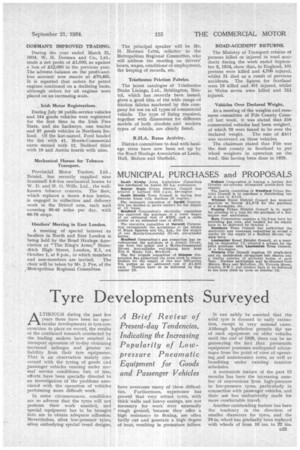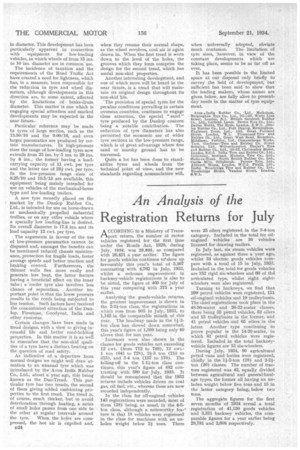Tyre Developments Surveyed
Page 81

Page 82

If you've noticed an error in this article please click here to report it so we can fix it.
A Brief Review of Present-clay Tendencies, Indicating the Increasing Popularity of Lowpressure Pneumatic Equipment for Goods and Passenger Vehicles
ALTHOUGH during the past few years there have been no spectacular developments in tyre con. struction to place on record, the results of the continued research conducted by the leading makers have resulted in transport operators of to-day obtaining increased mileages and greater reliability from their tyre equipment. That is an observation mainly concerned with the tyring of goods and passenger vehicles running under normal service conditions, but, of late, efforts have been specially directed to an investigation of the problems associated with the operation of vehicles performing more difficult work.
In some circumstances, conditions are so adverse that the tyres will not perform their work unaided, and special equipment has to he brought into use to •obtain adequate adhesion. Nevertheless, ultra low-pressure lyres, often embodying special • tread designs,
have overcome many of these difficulties. Furthermore, experience has proved that very robust tyres, with thick walls and heavy casings, are not necessary for work cri,.-er unusually • rough ground, because they offer a high resistance to flexing, are often badly, cut and generate a high degree of heat, resulting in premature failure.
It can safely he asserted that the solid tyre is doomed to early extinction, except in very unusual cases. Although legislation permits the use of such equipment on older vehicles until the end of 1039, there can be no gainsaying the fact that pneumatic equipment possesses undisputed advantages from the point of view of operating and maintenance costs, as well as benefiting under existing taxation schedules.
A noticeable feature of the past 12 months has been the increasing number of conversions from high-pressure to low-pressure tyres, particularly in connection with passenger vehicles, and their use has undoubtedly made for more comfortable travel.
Another outstanding feature has been the tendency in the direction of smaller diameters for tyres, and the 24-in, wheel has gradually been replaced with wheels of from 16 ins. to 22 ins. in diameter. This development has been particularly apparent its' connection with equipment for low-loading vehicles, in which wheels of from 15 ins.. to 10 ins, diameter are in common use.
The. incidence of taxation and the requirements of the Road Traffic Act have created a need for lightness, which has, in a measure, been responsible for the reduction in tyre and wheel diameters, although developments in this direction are, to some extent, .affected by the limitations of brake-drum diameter. This matter is one which is engaging special attention. and marked developments may be expected in the near future.• Particular reference may be made to tyres of large section, such as the 13.50/16 and the 9.00/16, and even larger pneumatics are produced by certain manufacturers. In high-pressure sizes the range of low-loading tyres now extends from 23 ins. by 5 ins. to 29 ins. by 8 mi.; the former having a loadcarrying capacity of 11 cwt. per tyre and the latter one of 28cwt. per tyre. In the low-pressure range -sizes of 8.25/10 and 10.5/13 are available, this equipment being mainly intended for use on vehicles of the mechanical-horse type and low-loading trailers.
A new tyre recently placed on the market by the Dunlop Rubber Co., Ltd., is intended for use on horse-drawn or mechanically propelled industrial trollies, or on any other vehicle where a specially low loading-line is desired. Its overall diameter is 17.8 ins, and its load capacity 12 cwt. per tyre.
The arguments in favour of the use of low-pressure pneumatics cannot be disputed and, amongst the benefits can be mentioned reduced chassis maintenance, protection for fragile loads, faster ,average speeds and better traction and braking control. Furthermore, the thinner walls flex more easily and generate less heat, the latter feature having a beneficial effect on the inner tube ; a cooler tyre also involves less chance of separation. Another important point is that the lower pressure results in the cords being subjected to less tension. Such factors have. received the concentrated attention of the Dunlop„ Firestone, Goodyear, . India and other coneerns.
Certain changes have been made in tread designs, with a view. to giving in.ereas&l life and better road-holding properties. In this matter it is as well to remember that the non-sIsid qualities of a tyre have a distinct bearing on the question of road ,safety.
As indicative .o.f a departure from normal designs we might well draw attention to an unusual tyre which was introduced by the Avon India Rubber Co., Ltd.; about a. year.agO, this being known as the Duo-Tread. This particular tyre has two treads, the second of them giving added cushioning pro-. perties to the first tread. The tread is, of course, much thicker, but to avoid deterioration through heating, a series of small holes passes from one side to the other at regular intervals around the tyre. When the holes are compressed, the hot air is expelled and,
D24 when they resume their normal shape, as the wheel revolves, cool air is again drawu in. When the first tread is worn down to the level of the holes, the grooves which they form comprise the design for the second tread, which has useful non-skid properties.
Another interesting development, and one of which more will be heard in the near future, is a tread that will maintain its original design throughout its non-skid life.
-The provision of special tyres for the peculiar conditions prevailing in certain overseas countries, continues to engage close attention, the special " sand " tyre produced by the Dunlop concern being a notable contribution. -The reduction of tyre diameters has also permitted the economic use of wider tyre. sections in the low-pressure range, which is of great advantage where fine sand or marshy ground has to be traversed.
Quite a lot has been done to standardize tyres and wheels from the technical point of view, and the new standards regarding nomenclature will, when universally adopted, obviate much confusion. Thelimitation of tyre sizes, however, in view of the constant developments which are taking place, seems to be as far oft as
ever.
It has been possible in the limited space at our disposal only briefly to survey the field of development, but sufficient has been said to show that the leading makers, whose names are given below, are fully alive to presentday needs in the matter of' tyre equipment.
Avon 'audio, Rubber Co., Ltd., Meacham. Bergouguan Tyre Co., Ltd., 95-100, White Loon Street, London, N.1. Britdsb Goodrich Rubber Co., Ltd., Leyland, Lancs. Davies Tyre Co., Ltd., Davies Works, The Hyde, London,.N.W.9.....Dmi. lop Rubber Co., Ltd., Fort Dunlop, Birmingham. Englebert Tyres, Ltd., 162, Great Portland Street, London, W.1. Firestonot Tyre and Rubber Co., Ltd., Great West. Road, Drentiord, Middlesex. Fortifex, Ltd., Clementhorpe Works, York. Goodyear/Tyre and Rubber Co. (Great Britain), Ltd., Wolverhampton. IrenleY's Tyre and Rubber Co., Ltd., 20-22, Christopher Street, Louden, 110.2. India Tyre andRabber GO, Ltd., Inobinnan. Scotland. Michelin Tyre Co., Ltd:, Stoke-on-Trent. North Riltish Rubber Co., Ltd., Castle Mills, dinburgh. Palmer Tyre, Ltd., Atdwych House, London, W.C.2. Pirelli, Ltd., Derby. 'Trowbridge Tyre and. Rubber Co., Ltd., Trowbridge Rouse, Vandon Street. Landon,








































































































































































